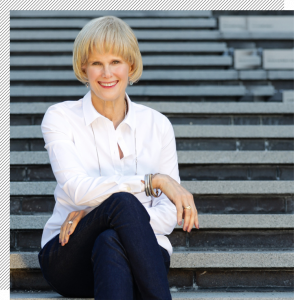You have years of experience in your industry. Along with the knowledge and expertise to distinguish yourself. But how do you stand out and build your reputation as an expert? The key is executive personal branding.
What is executive personal branding and how can it help your career?
Let’s answer those two important questions and then consider some powerful points of how you can do it yourself.
What is Executive Personal Branding
We’ve talked about personal branding in general — but what does it mean to develop an executive personal brand?
A personal brand is what differentiates you from others in your industry — it could be your expertise, your knowledge, background, and even personality. It highlights those differences to attract people to you.
An executive personal brand takes those same principles and applies them to those in or seeking leadership positions. It helps those in the C-suite, or aspiring to be there, to develop and hone their public identity to support their company’s goals.
Before we get into specifics about how to do it, here are a few tips to remember as you develop your own executive brand…
- Be authentic — However you develop your personal brand, never lose sight of who you are. People can sniff out a fake, so remain true to your personality and values.
- Stand out — An executive personal brand is all about distinguishing you. What differentiates you from others in your industry? This could be your expertise, your background and experience, even your personal story. Whatever it is, highlight that difference.
- Boost your credibility — Give people a reason to believe in your brand. Keep your brand messaging realistic and relatable. Share what in your background gives you the authority to speak on industry topics.
Why is Executive Personal Branding Important?
So now we know what it is, why bother developing your own personal brand as an executive or would-be executive?
Executive branding has many layers of benefits, both tangible and intangible.
Let’s start with the intangible.
First, executive brand authority gives you cachet, distinguishing you from your industry peers and spotlighting your opinions. When people want expertise, they will come to you because you have developed a reputation.
It also elevates your credibility. People trust you and want to work with you because you are a known entity.
Now for the tangible.
When you have an established executive brand, networking becomes a lot easier. You’ll find people eager to connect with you because of your industry presence. You never know what opportunities this could bring your way.
In addition, you’ll be able to charge a premium for your services. People will be more willing to pay extra to work with a proven industry expert.
Lastly, a reputable executive brand has the power to attract a more elite class of investors and clients. Well-known names and brands are more comfortable doing business with proven experts, which executive branding helps to establish.
All right. We’ve proven it’s important — but what does executive personal branding involve?
Let’s examine 10 key strategies to help you develop your executive personal brand and realize the results we’ve mentioned.
10 Strategies That Will Help You in Your Executive Personal Branding
1. Define Your Brand
Who are you? What industry expertise do you possess? What do you stand for? These questions are crucial elements of your executive personal brand. And you need to lay the groundwork by defining a few parameters first.
Avoid the “jack of all trades” brand and narrow down where your expertise lies. Determine which problems you are best at solving and what you’re most passionate about in your industry.
This will involve some soul searching. Don’t seek an image that you think other people want to see — it won’t be authentic. Instead, determine what niche or specialty best represents your skills and even your core values.
2. Determine Your Audience
An audience is what adds value to your brand.
How do you find your audience?
First, sit down and identify your target, who will be drawn to you and who you can and want to serve? What problems do they have that you can solve?
Draft a summary that pinpoints your ideal audience, including your audience’s demographics, job position, concerns, and problems. Be detailed — you can always prune down the road.
This will help you create content that specifically speaks to your audience. Remember: A personal brand is not about appealing to everyone. It’s s providing valuable to a select audience who will remain loyal to your brand.
3. Invest in a Website
It’s nearly impossible to do business today without a website and the same goes for your executive brand.
More than almost any other asset, you are in complete control of your website. You can customize everything from font, to photos, to messaging.
First, choose a platform for your website.
There are several options when it comes to building a website. Website builders like Squarespace and Wix give you many design options with the ability to customize it to your liking. Another easy and less expensive option is to use WordPress to build it yourself. Whatever your skills, there’s a website solution that will fit them.
To ensure that your website will be found, you need to optimize it for search engines — a process called search engine optimization, or SEO for short. This is the process of choosing keywords or key phrases and strategically placing them throughout your site so that Google can appropriately index it.
4. Establish Yourself on Social Media
Social media is the next crucial element to your executive brand.
But there are many social media networks to choose from — from the tried and true Twitter and LinkedIn, to the newer yet powerful Clubhouse. Which networks you choose will depend on who your target audience is. Look at where they spend time online and what networks they use for business. This will help you to narrow down which networks are most applicable for your brand.
Once you land on one to two social networks, it’s time to build your profile. Write your bio, completing an engaging description of you and upload an attractive, clear photo of yourself.
Once your profile is established to showcase who you are as an executive, it’s time to get social. This means posting a regular stream of industry-related content. This could be content from your own website or articles that you find valuable. Find and join groups where you can meaningfully add to the conversation. And engage with your audience by commenting on and sharing other people’s posts and responding to comments on your own.
Once you get into the swing of things on social media, you will find it to be a powerhouse for your executive branding strategy.
5. Leverage LinkedIn
Yes, I know, LinkedIn is a social media network. But I want to spend a little more time on this specific network.
Why?
Because LinkedIn is a non-negotiable social network when it comes to your executive brand.
LinkedIn is so much more than a social media network or a place to house your online resume.
Let’s first talk networking. On LinkedIn, you can reach out and connect with people you already know. But LinkedIn groups also give you the opportunity to mingle with others in your industry. And there are groups for almost everything under the sun. Look up your industry and see what pops up.
I also love LinkedIn for its publishing tools. Part of establishing your personal brand is furnishing proof of your expertise. LinkedIn’s publishing platform lets you write articles on any subject. Better yet, those articles will stay with your LinkedIn account forever. You’re building a solid block of evidence that you are the industry expert you claim to be.
Seriously, LinkedIn has so many features and they’re frequently enhancing it with new ones. Start looking at your LinkedIn account and see how you can maximize its use.
6. Create Content
Sharing other people’s content on social media will get you only so far. Instead, start creating your own content.
This could be a blog post, an ebook, an infographic, or even a video. This content lives on your website and is a great way to attract your audience to learn more. People may visit your site to read a blog post that answers a question, but stay to learn more about your brand.
What should you create content about? Think about the most common questions that people ask and what problems they’re facing. Then, create content that addresses each of those questions and problems. You might even find inspiration from articles that other experts have written. Just ensure you’re adding your own perspective to the conversation.
Don’t be a once and done content creator. That is like eating healthy one day and thinking you’re now on track for a healthy life. Just like you need to consistently eat well to maintain your health, you also need to regularly post content. Think about creating a content calendar to keep you on track.
7. Speak at Industry Events
Now that you’ve established your authority with a website, social media, and content, you’re ready to spread your wings.
The more visible you are, the more people will see you as an expert and the more robust your brand will become.
Industry events are key way to do this. Discover what events or conferences are happening in your industry, whether they’re in a physical location or virtual.
In the beginning, shoot for smaller events. These will be easier for you to land as a speaker and they will also help you get experience as a speaker. Eventually, you might work your way up to doing larger, regional, national or even international events.
Consider adding a page on your website where people can contact you about speaking at an event. Include examples of your past speaking engagements and topics you’re comfortable speaking about.
8. Become a Source
Content that you create is a great resource but when you can land a mention in a publication, it has the power to elevate your authority and credibility.
But how do you get writers and journalists to mention you?
You need to let them know you’re available. A great resource to help you do this is HARO, or Help a Reporter Out. Here, you can register as a source, fill in some basic information about your expertise, and get emails about journalists who are looking for sources in your industry.
You might also look on Twitter. Follow journalists who cover your industry or even search common industry hashtags. You never know when you’ll come across someone seeking an immediate source.
9. Guest Post
As you’re establishing your executive personal brand, the content on your website will reach only so far. A great way to expand you audience is to guest post on someone else’s blog. This is an arrangement where another website posts your article, with a byline that describes who you are and what you do and often a link back to your site.
This is a great way to expose new audiences to your brand. It might even lead them to visit your site and start following you. Either way, you’re getting known to more people. Even if people don’t do anything immediately with your guest post, it plants a seed. And you never know where that might lead.
10. Measure the Results from Executive Personal Branding
From the get go, track the progress of your executive brand, just as you would for an actual company brand.
On your website, use a a free program like Google Analytics. This will show how many people visit your site, what pages they visit, and whether they stay for a while or leave quickly. From this information, you can determine what’s working and what you need to change.
The same goes for social media. Many social media networks have analytics built right in to the platform although you might need a business profile to get more details on some networks. Either way, you’ll see who follows you, where they’re from, and which posts get the most likes.
Information is power — so make sure to gather as much information as possible and use that to make your executive brand more robust.
Concluding Thoughts About Executive Personal Branding
Executive branding is a great strategy that can help you to land key clients, attract the right investors, and to charge what you’re worth.
But remember, an executive brand does not happen overnight. It will take time and effort. But if you’re committed to developing your brand, the ROI will be impressive.
I hope these points help you to develop your own executive personal branding strategy.
Photo by Yibei Geng on Unsplash






2 Responses
Awesome tips Wendy! Thank you so much for sharing such valuable info!
Thank you, Lisa, for taking the time to tell me that. So good to hear.